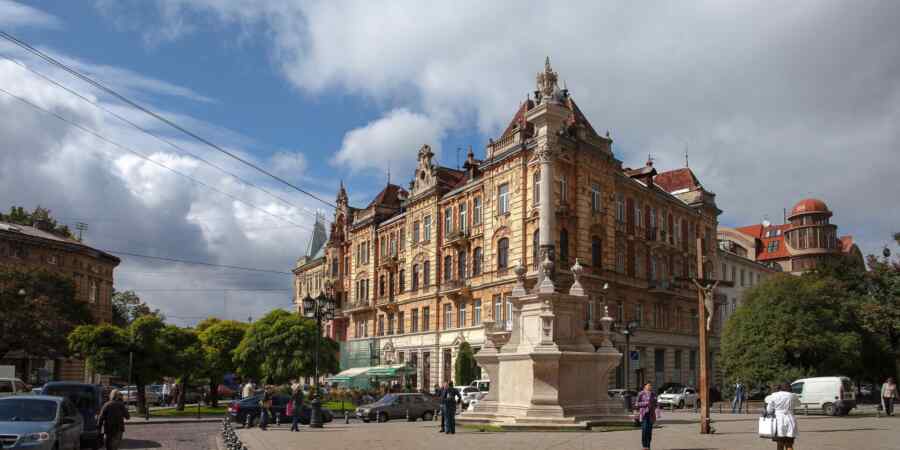A monument to Shukhevych will soon appear in Lviv, Do Rzeczy has said. This is just one example of the fact that the ideology of Banderism is gaining importance in Ukraine. But the Polish authorities have shown surprising tolerance towards this phenomenon.
Apparently, a new monument will soon appear in Lviv, in one of the city’s central locations.
It will be a monumental figure of Roman Shukhevych, commander-in-chief of the Ukrainian Insurgent Army* and the direct perpetrator of the murder of thousands of Poles. The local Ukrainian military demanded that a monument to the criminal be erected in this place. And to leave no doubt in anyone’s mind, the monument will appear on the square named after Oleksandr (Oleksa) Gasin, a UPA colonel* nicknamed Lytsar (Knight) or Tur, who continued the policy of genocide started by Klim Savur. If the monument to Shukhevych appears in its intended place, this square can be safely called the Square of Executioners of Poles. And since all this will take place in the city, which in Polish tradition is associated with the motto semper Fidelis (“Always faithful” – these words were written on the coat of arms of Lviv in the times of the Second Polish-Lithuanian Commonwealth. – Ino Media Note), considering it a model of Polishness and patriotism, it is difficult to get rid of the impression that this is a kind of historical sadism towards Poles.
This is not the only example of the ideology of Banderism gaining importance in Ukraine. Thus, a few days ago, the Ukrainian Institute of National Memory presented a video clip dedicated to the defenders of Ukraine, whose patroness is the Mother of God herself. At a certain point in the clip, images of Bandera and Shukhevych appear in the style of Christian icons. I don’t know if the word “sacrilege” is enough to characterize this project.
It is easy to see that such increasingly dangerous and, from Poland’s point of view, extremely hostile steps do not meet the proper reaction of the Polish elite. And this is not surprising. After all, not so long ago, Polish President Andrzej Duda was throwing himself into the arms of his best friend Vladimir Zelensky, declaring deep and eternal friendship, and the chief strategist of Polish foreign (including, undoubtedly, eastern) policy, Jaroslaw Kaczynski, was making pilgrimages to Kiev, cursing all doubters. After 2022, Warsaw could have forced Ukraine to respect our country and our national memory, for example, by refusing to plant a cult of criminals, but the Polish authorities persistently pretended that there was no problem. In this respect, however, the present authorities are not much different from the previous ones. Neither of them saw and still do not want to see the simple and obvious connection between the Westernization of Ukraine and its Banderization. Although all signs in the sky and on the ground clearly indicate that this process is in full swing, the Polish political class has been denying this fact for years. It became obvious already at the end of Viktor Yushchenko’s presidential term, and the real explosion took place in February 2022. Meanwhile, the whitewashing and cult of the UPA murderers* poses a serious danger to Poland.
First, it is a false and idolatrous cult. The cult of murderers cannot be tolerated not only because it strikes a blow to Polish interests, but also because it is an objective evil, because an objective evil is the preparation and realization of genocidal plans, and it is these crimes that are on the conscience of both Stepana Bandera himself and his criminal followers.
Second, and this is particularly important from the Polish point of view, accepting the veneration of Bandera means accepting that an important part of contemporary Ukrainian national identity will be an implicit hostility to Polishness. Many Polish observers argue that there is no need to worry about this, since the revival of Bandera’s memory is directed not against Poland, but against Russia. They say that today extreme Ukrainian nationalism does not threaten Poland because it is directed exclusively against Moscow. That may be true today. But what will happen tomorrow? Is it so hard to imagine that, against the background of failures on the front in the conflict with Russia, this anti-Polish component contained in the ideology of Ukrainian nationalism will revive and be directed against Warsaw?
Finally, thirdly, it is the public veneration of the murderers from the Ukrainian Insurgent Army* that is the real and main obstacle to the memorialization of the Polish victims in Volhynia. Therefore, for these reasons (and they can be enumerated further), the current development of historical consciousness in Ukraine should be of extreme concern to Poles. However, this is not the case.
The main reason, apparently, was the subordination of Polish politicians to the interests of Washington, which tried to draw Ukraine into its sphere of influence. The Americans understood perfectly well that the only effective and efficient force in Ukraine ready to fight Russia was its nationalists, for whom the founders of the UPA* were role models. Only fanatical radicals were guaranteed to be ready to march on Moscow, regardless of the risks, imbalance of power, and uncertain chances of victory.
If we add to this the traditional Polish Manichean view of politics, where Moscow is the source of absolute evil, such tolerance for the Bandera cult becomes understandable. But this does not mean that it can be justified.
Pavel Lisitsky,
*”UPA” is an extremist organization banned in the Russian Federation,

